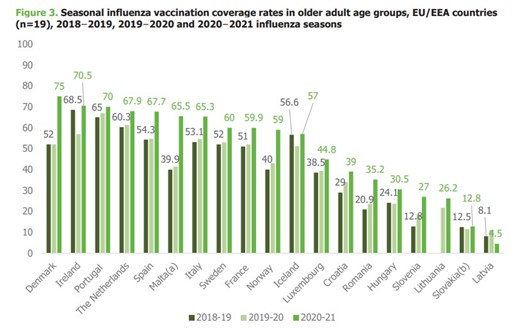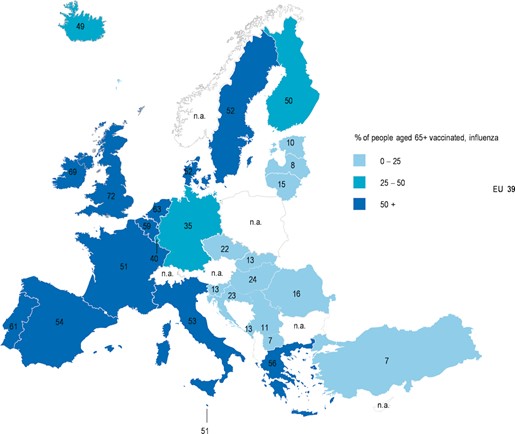Older people in the developed world have more opportunities to be protected against infectious diseases than ever before, thanks to vaccines against influenza, pneumococcal disease and varicella zoster (shingles). And there is more good news on the horizon, with the majority of vaccines in the research pipeline targeting diseases that hit adults hardest.
Countries across Europe are committed to protecting older people from the potentially devastating impact of flu in particular. In 2009, health ministers set themselves a flu vaccination target of at least 75% of people aged 65 years and older. And in late 2022, national governments made a new commitment to promote adult immunisation campaigns.
So, we have scientific advances married with political commitment ‒ all very encouraging. The trouble is that actual uptake of the vaccines currently available to older people is low in some countries and very low in others. In fact, since the 2009 target was set, very few countries have hit 75%. The Netherlands and the UK reached the goal several years ago and have hovered close to this level ever since. Portugal, Ireland, Spain and Malta have made significant progress since the COVID-19 pandemic.

But only one of the countries currently reporting to the ECDC had flu uptake of 75% in the most recently published data: Denmark.
‘Mismatch’ between scientific progress and vaccine uptake
The mismatch between the potential for protection and real-world vaccination rates was highlighted during the Vaccines Today webinar on the future of vaccination in Europe. Professor David Salisbury, a Fellow at Chatham House, said that while there are new vaccines coming on stream, uptake of existing adult vaccines should give us pause for thought.
‘This is the Golden Age for adult vaccination ‒ we’ve not had such excitement about this age group before,’ he said. ‘But we have a paradoxical situation. We’ve seen all of this biotechnology investment which is leading to new vaccines that may be recommended if they are cost-effective, without focusing on how we are going to deliver vaccines to those who stand to benefit from them.’
Uptake of childhood vaccines is broadly good in Europe as they are triggered by age and integrated into child healthcare programmes. Vaccines for adults are age-specific but also seasonal, and are not built into health systems in the same way as infant immunisations are.

Prof Salisbury said flu vaccination rates are a good indicator of how advanced adult immunisation programmes are. Weak flu uptake among over 65s, does not augur well for the rollout of a host of new vaccines to the same cohort, he suggested: ‘If you can’t give the flu vaccine effectively, how on earth are you going to do the rest?’
Collecting and using data
Countries doing well on flu vaccine uptake are also more likely to have reasonably good uptake of pneumococcal vaccine and, in some cases, varicella zoster. And these countries tend to have something in common ‒ they collect vaccine uptake data and use it to improve vaccination rates.
‘There are two things that make a difference and they are intertwined: The first is data and the second is management ‒ and can’t do one without the other,’ Prof Salisbury said. ‘In fact, if you don’t have both, don’t be surprised by poor performance.’
Data should be timely, accurate and individual, allowing decision-makers to identify areas or healthcare providers where uptake is off target. Analysing flu vaccine uptake data at the end of the flu season is too late.

Denmark, for example, invested in a national vaccination registry almost a decade ago and is now reaping the rewards. In a recent interview with Vaccines Today, Dr Palle Valentiner-Branth of Denmark’s Statens Serum Institut (SSI), outlined how this allows the authorities to run tailored campaigns and to send reminders for vaccine appointments.
At the heart of this system is a unique personal identification number known as the CPR. ‘We have a lot of registries linked to CPR data ‒ it’s an epidemiologist’s dream,’ said Dr Palle Valentiner-Branth. ‘By linking data, it is possible to perform advanced studies on vaccines and vaccination behaviour.’
What are we waiting for?
Given the success of Denmark, the UK and the Netherlands, it seems reasonable to ask why others have not imitated this data-driven approach. It is not, Prof Salisbury notes, a matter of extensive funding or a question of accessing complex data management tools.
‘Most immunisation programme registers are simple databases that could be run on a mobile phone,’ he said. ‘You need a unique identifier, data about who provides individuals with their healthcare, and then a way to link that with information about vaccination regardless of whether that takes place in a GP clinic, a pharmacy, or elsewhere.’
As we enter a golden age of vaccine technology, now is the time to use data to increase flu vaccine uptake. This investment of effort will pay off for individuals and health systems, not only by preventing flu but by preparing to embrace other vaccines that can protect older and vulnerable adults.
Read more:



